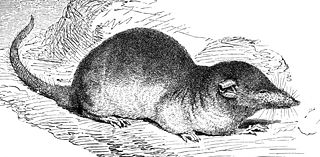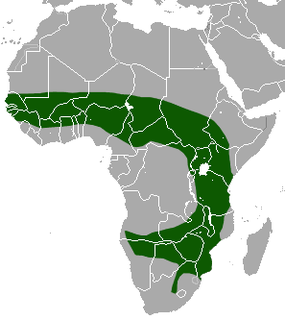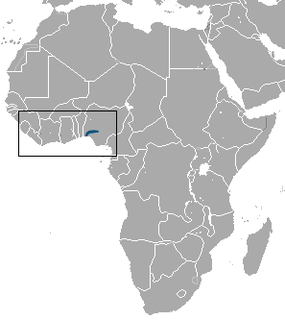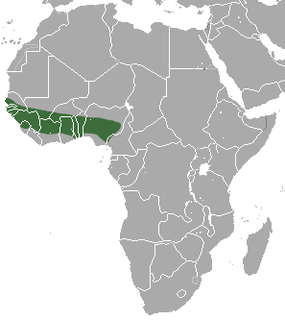
Ivory Coast is a sub-Saharan nation in southern West Africa located at 8 00°N, 5 00°W. The country is approximately square in shape. Its southern border is a 515 km (320 mi) coastline on the Gulf of Guinea on the north Atlantic Ocean. On the other three sides it borders five other African nations for a total of 3,458 km (2,149 mi): Liberia to the southwest for 778 km (483 mi), Guinea to the northwest for 816 km (507 mi), Mali to the north-northwest for 599 km (372 mi), Burkina Faso to the north-northeast for 545 km (339 mi), and Ghana to the east for 720 km (447 mi).

The white-toothed shrews or Crocidurinae are one of three subfamilies of the shrew family Soricidae.

The wildlife of Cameroon is composed of its flora and fauna. Bordering Nigeria, it is considered one of the wettest parts of Africa and records Africa's second highest concentration of biodiversity. To preserve its wildlife, Cameroon has more than 20 protected reserves comprising national parks, zoos, forest reserves and sanctuaries. The protected areas were first created in the northern region under the colonial administration in 1932; the first two reserves established were Mozogo Gokoro Reserve and the Bénoué Reserve, which was followed by the Waza Reserve on 24 March 1934. The coverage of reserves was initially about 4 percent of the country's area, rising to 12 percent; the administration proposes to cover 30 percent of the land area.

Bates's shrew is a species of mammal in the family Soricidae. It is found in Cameroon, Republic of the Congo, Equatorial Guinea, and Gabon. Its natural habitat is subtropical or tropical moist lowland forests. This large black shrew was first described by the British zoologist Guy Dollman in 1915, the type locality being the vicinity of the Como River in Gabon. The exact definition of this species is unclear; it is often included in Fraser's musk shrew, or reported as Wimmer's shrew. Its karyotype is 2n=50, FN-76, which is identical to the Nigerian shrew, and the species complex is in need of a thorough revision.

Buettikofer's shrew is a species of mammal in the family Soricidae. It is found in southern Nigeria and scantly present in Ivory Coast, Ghana, Guinea, Liberia and Sierra Leone. Its natural habitat is subtropical or tropical moist lowland forests.

Crosse's shrew is a species of mammal in the family Soricidae. It is found in Benin, Cameroon, Ivory Coast, Ghana, Guinea, Liberia, Nigeria, Sierra Leone, and Togo. Its natural habitat is subtropical or tropical moist lowland forests.

Dent's shrew is a species of mammal in the family Soricidae. It is found in Cameroon, Central African Republic, Republic of the Congo, Democratic Republic of the Congo, Equatorial Guinea, Gabon, Guinea, Liberia, Nigeria, Sierra Leone, and Uganda. Its natural habitats are subtropical or tropical moist lowland forest and moist savanna.

Fox's shrew is a species of mammal in the family Soricidae. It is found in Benin, Burkina Faso, Cameroon, Central African Republic, Chad, Ivory Coast, Gambia, Ghana, Guinea, Guinea-Bissau, Mali, Nigeria, Senegal, South Sudan, and Togo. Its natural habitats are subtropical or tropical moist lowland forest, moist savanna, and plantations.

The bicolored musk shrew is a species of mammal in the family Soricidae. It is found in Angola, Benin, Botswana, Burkina Faso, Burundi, Cameroon, Central African Republic, Chad, Democratic Republic of the Congo, Ivory Coast, Ethiopia, Gambia, Ghana, Guinea, Guinea-Bissau, Kenya, Lesotho, Malawi, Mali, Mauritania, Mozambique, Namibia, Niger, Nigeria, Rwanda, Senegal, Sierra Leone, South Africa, Sudan, Tanzania, Togo, Uganda, Zambia, and Zimbabwe. Its natural habitats are savanna, subtropical or tropical dry lowland grassland, and hot deserts.

Crocidura grandiceps is a species of mammal in the family Soricidae. It is found in Benin, Ivory Coast, Ghana, Guinea, Liberia, Nigeria, and Togo. Its natural habitat is subtropical or tropical moist lowland forests. It is threatened by habitat loss due to agriculture and aquaculture as well as logging and wood harvesting. To increase habitat protection for the C. grandiceps, in-place land/water protection conservation actions are in place. The vernacular name large-headed shrew is sometimes applied to C. grandiceps but has also been used for the entire related genus Paracrocidura. The IUCN List categorizes the C. grandiceps as Near Threatened as of 2008.

Lamotte's shrew is a species of mammal in the family Soricidae. It is found in Benin, Burkina Faso, Cameroon, Ivory Coast, Gambia, Ghana, Guinea, Guinea-Bissau, Liberia, Mali, Nigeria, Senegal, Sierra Leone, and Togo. Its natural habitat is savanna.

The West African long-tailed shrew is a species of mammal in the family Soricidae. It can be found in Ivory Coast, Ghana, Guinea, Liberia, and Sierra Leone. Its natural habitat is subtropical or tropical moist lowland forests.

The Nimba shrew is a species of mammal in the family Soricidae. It is found in Ivory Coast, Guinea, Liberia, and Sierra Leone. Its natural habitat is subtropical or tropical moist lowland forests.

The West African pygmy shrew or obscure white-toothed shrew is a species of mammal in the family Soricidae. It is found in Ivory Coast, Ghana, Guinea, Liberia, and Sierra Leone. Its natural habitat is subtropical or tropical moist lowland forests.

Fraser's musk shrew is a species of mammal in the family Soricidae. It is found in Benin, Cameroon, Ivory Coast, Equatorial Guinea, Ghana, Guinea, Liberia, Nigeria, São Tomé and Príncipe, Sierra Leone, and Togo. Its natural habitat is subtropical or tropical moist lowland forests. This large black shrew was first described by the British zoologist Louis Fraser in 1843. Its exact definition is unclear; the karyotype comes from Ivory Coast but not from Equatorial Guinea, which is given as the type locality.

Therese's shrew is a species of mammal in the family Soricidae. It is found in Ivory Coast, Ghana, Guinea, Liberia, and Sierra Leone. Its natural habitats are subtropical or tropical moist lowland forest and moist savanna.

The climbing shrew is a species of mammal in the family Soricidae, which is found in subtropical Africa. It is found in Angola, Benin, Burundi, Cameroon, Central African Republic, Republic of the Congo, Democratic Republic of the Congo, Ivory Coast, Ethiopia, Ghana, Guinea, Kenya, Liberia, Malawi, Mozambique, Nigeria, Rwanda, Sierra Leone, South Sudan, Tanzania, Togo, Uganda, Zambia, and Zimbabwe. Its natural habitats are subtropical or tropical moist lowland and montane forests, and moist savanna.
The Mount Nimba giant forest shrew is a species of mammal in the family Soricidae. It is native to West Africa, where it is found in Ivory Coast, Guinea, Liberia, and Sierra Leone.

















